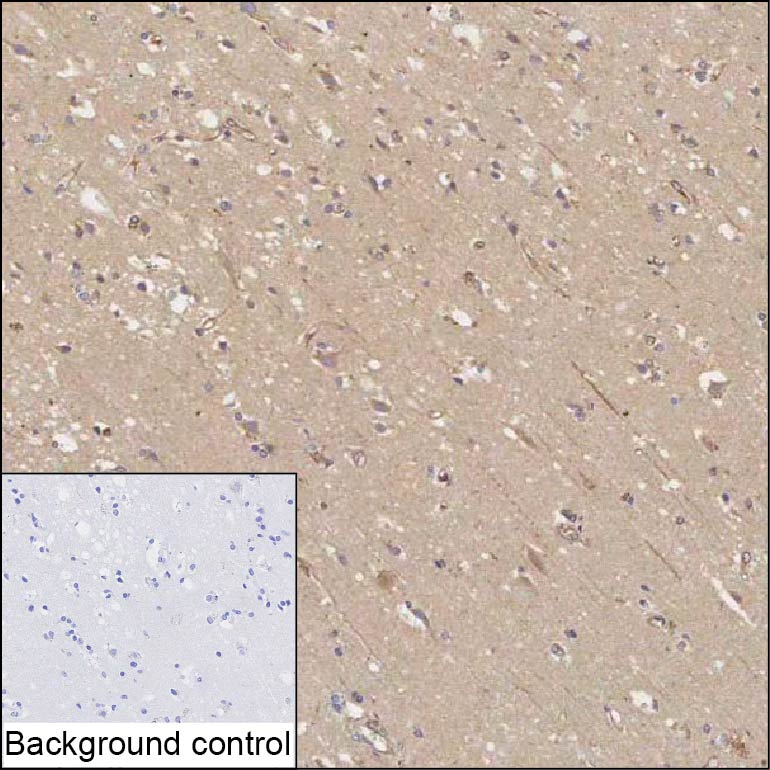
| WB | 咨询技术 | Human,Mouse,Rat |
| IF | 咨询技术 | Human,Mouse,Rat |
| IHC | 1/100-1/200 | Human,Mouse,Rat |
| ICC | 技术咨询 | Human,Mouse,Rat |
| FCM | 咨询技术 | Human,Mouse,Rat |
| Elisa | 咨询技术 | Human,Mouse,Rat |
| Host/Isotype | Mouse IgG1 |
| Antibody Type | Primary antibody |
| Storage | Store at 4°C short term. Aliquot and store at -20°C long term. Avoid freeze/thaw cycles. |
| Species Reactivity | Human |
| Immunogen | Purified recombinant fragment of human MGRN1 |
| Formulation | Purified antibody in PBS with 0.05% sodium azide |
+ +
以下是关于MGRN1抗体的3篇参考文献及其摘要概括:
---
1. **文献名称**: *"Mahogunin Ring Finger-1 (MGRN1) suppresses chaperone-associated misfolded protein aggregation and toxicity"*
**作者**: Chakrabarti O., et al.
**摘要**: 本研究通过Western blot和免疫荧光技术,利用MGRN1特异性抗体,揭示了MGRN1作为E3泛素连接酶调控错误折叠蛋白(如朊病毒蛋白)的聚集过程,并证明其缺失导致细胞内蛋白毒性增加。
---
2. **文献名称**: *"MGRN1 interacts with amyloid precursor protein and regulates its trafficking and processing"*
**作者**: Singh A., et al.
**摘要**: 作者使用MGRN1抗体进行免疫共沉淀实验,发现MGRN1与淀粉样前体蛋白(APP)相互作用,影响其细胞内运输及加工,提示MGRN1在阿尔茨海默病病理中的潜在作用。
---
3. **文献名称**: *"Developmental regulation of Mahogunin Ring Finger-1 (MGRN1) expression in mammalian brain"*
**作者**: Kim J., et al.
**摘要**: 通过免疫组化和免疫印迹分析,利用MGRN1抗体检测其在小鼠大脑发育不同阶段的表达分布,发现MGRN1在神经元成熟和突触形成中具有时空特异性表达模式。
---
4. **文献名称**: *"MGRN1 deficiency promotes oxidative stress and melanosome abnormalities in vitiligo"*
**作者**: Gupta S., et al.
**摘要**: 研究通过MGRN1抗体分析患者黑色素细胞,发现MGRN1缺失导致氧化应激反应增强及黑色素体结构异常,为白癜风的分子机制提供了新见解。
---
以上文献均通过MGRN1抗体进行蛋白定位、相互作用或表达分析,涵盖神经退行性疾病、发育生物学及皮肤病理等领域。
The MGRN1 (Mahogunin Ring Finger 1) antibody is a research tool used to study the MGRN1 protein, an E3 ubiquitin ligase involved in ubiquitination processes that regulate protein degradation, trafficking, and signaling. MGRN1 is encoded by the *MGRN1* gene and plays roles in diverse physiological pathways, including neurodevelopment, melanogenesis, and mitochondrial function. It interacts with proteins such as TSG101 and modulates cellular stress responses. Dysregulation of MGRN1 has been linked to neurodegenerative conditions, as its loss in animal models causes spongiform encephalopathy, ataxia, and premature lethality. Mutations in *MGRN1* are also associated with altered pigmentation in mice and may contribute to human metabolic or neurological disorders.
MGRN1 antibodies are primarily used in Western blotting, immunohistochemistry, and immunofluorescence to detect protein expression, localization, and interactions in tissues or cultured cells. These antibodies help investigate MGRN1’s role in cellular quality control, its association with prion-like pathologies, and its potential involvement in cancer or metabolic syndromes. Commercial MGRN1 antibodies are typically validated for specificity using knockout controls or siRNA-mediated knockdown. Researchers utilize these tools to explore mechanisms underlying neurodegeneration, mitochondrial dysfunction, and ubiquitin-dependent signaling pathways. Despite progress, the full scope of MGRN1’s functions and its therapeutic relevance remain active areas of study.
×